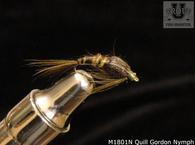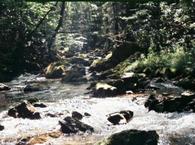The Great Smoky Mountains National Park (GSMNP)
 The Great Smoky Mountains National Park, with over 2,115 miles of free flowing streams, and protects one of the last wild trout habitats in the Eastern United States. Many of the streams in the Great Smoky Mountains National Park can be accessed by simply pulling over to the roadside parking areas. But, for the more active anglers, it has fishing trails as well as back country campsites. So whatever your choice, a visit to the Great Smoky Mountains National Park, promises to be a rewarding experience. The GSMNP is deserving of this special section where some of the more fishable streams will be discussed. Also, visit our page on the Top Five Great Smoky Mountains National Park Fishing Resources
The Great Smoky Mountains National Park, with over 2,115 miles of free flowing streams, and protects one of the last wild trout habitats in the Eastern United States. Many of the streams in the Great Smoky Mountains National Park can be accessed by simply pulling over to the roadside parking areas. But, for the more active anglers, it has fishing trails as well as back country campsites. So whatever your choice, a visit to the Great Smoky Mountains National Park, promises to be a rewarding experience. The GSMNP is deserving of this special section where some of the more fishable streams will be discussed. Also, visit our page on the Top Five Great Smoky Mountains National Park Fishing Resources
Which Flies to Use? See the GSMNP Collection of Perfect Flies.
Great Smoky Mountains National Park Hatch Chart
Abrams Creek Contains the largest wild rainbow trout in the GSMNP.
Cataloochee Creek A good population of brown in the lower end.
Cherokee Tribal Waters Adjacent to GSMNP managed by the Cherokee Indians.
Deep Creek our favorite stream for big wild trout.
Hazel Creek The absolute queen of remoteness.
Little River East Prong Productive stream with browns as large as 20 inches.
Little River Middle Prong Dry flies do exceedingly well on this scenic river.
Little River West Prong Small often overlooked stream with good potential.
Middle prong of the Little Pigeon River Known locally as the Greenbrier.
Oconaluftee River The most accessible river on the North Carolina side..
Raven Fork The most difficult and the most rewarding stream in the park.
Twentymile Creek is probably one of the least visited stream in the GSMNP.
View Great Smoky Mountains National Park Fly Fishing Guide in a larger map
Troutu's Smoky Mountains Blogs
* Great Smoky Mountains National Park clickable trail map from the Library of Congress
* Trail maps are available at the Great Smoky Mountains National Park Visitor Centers.
* Learn the rules and regulations for the Great Smoky Mountains National Park.





